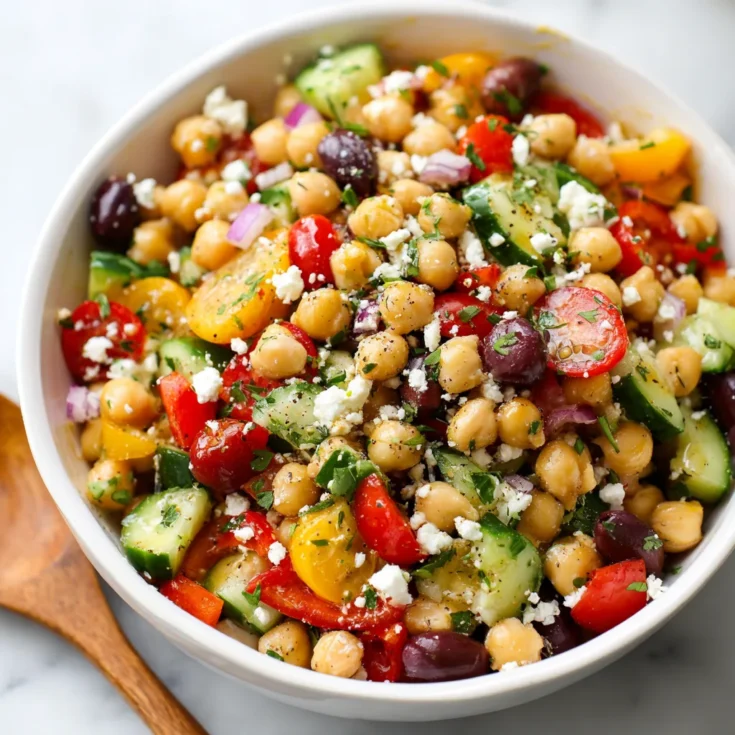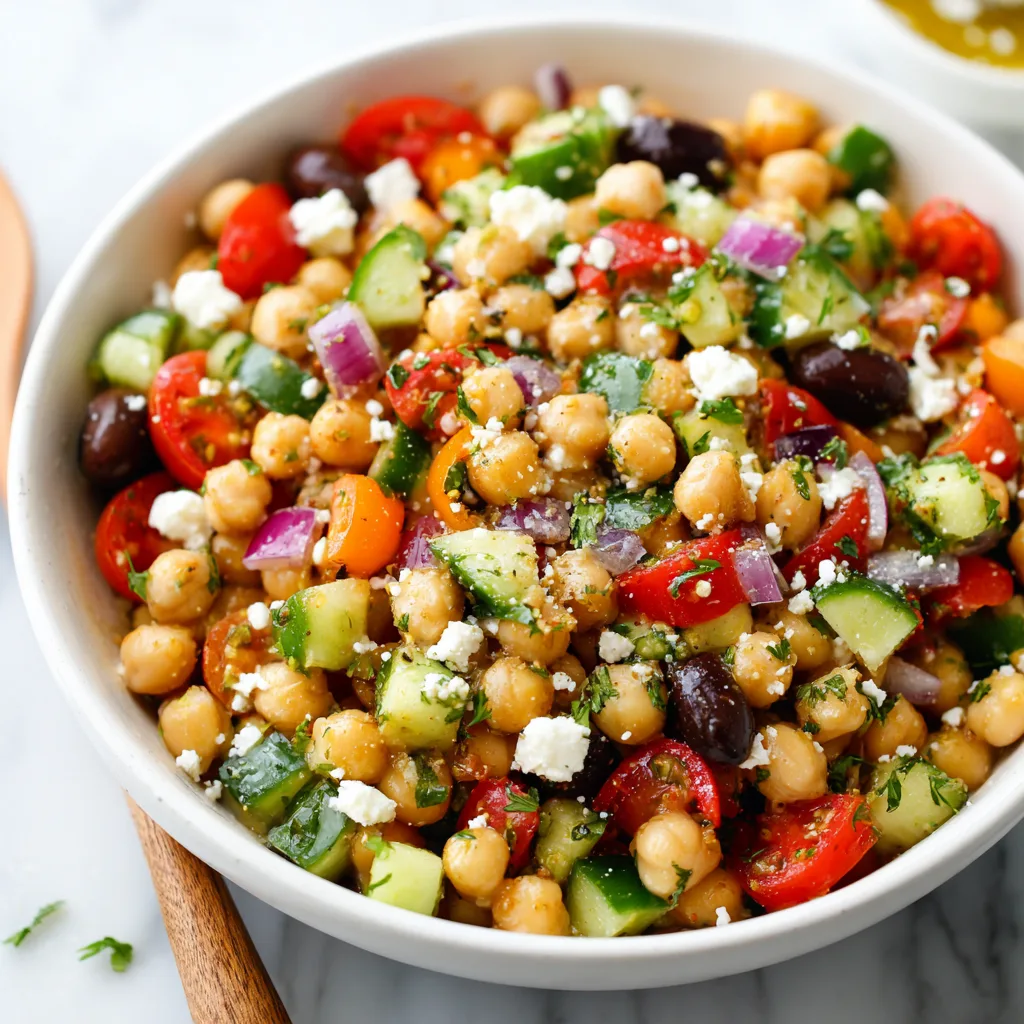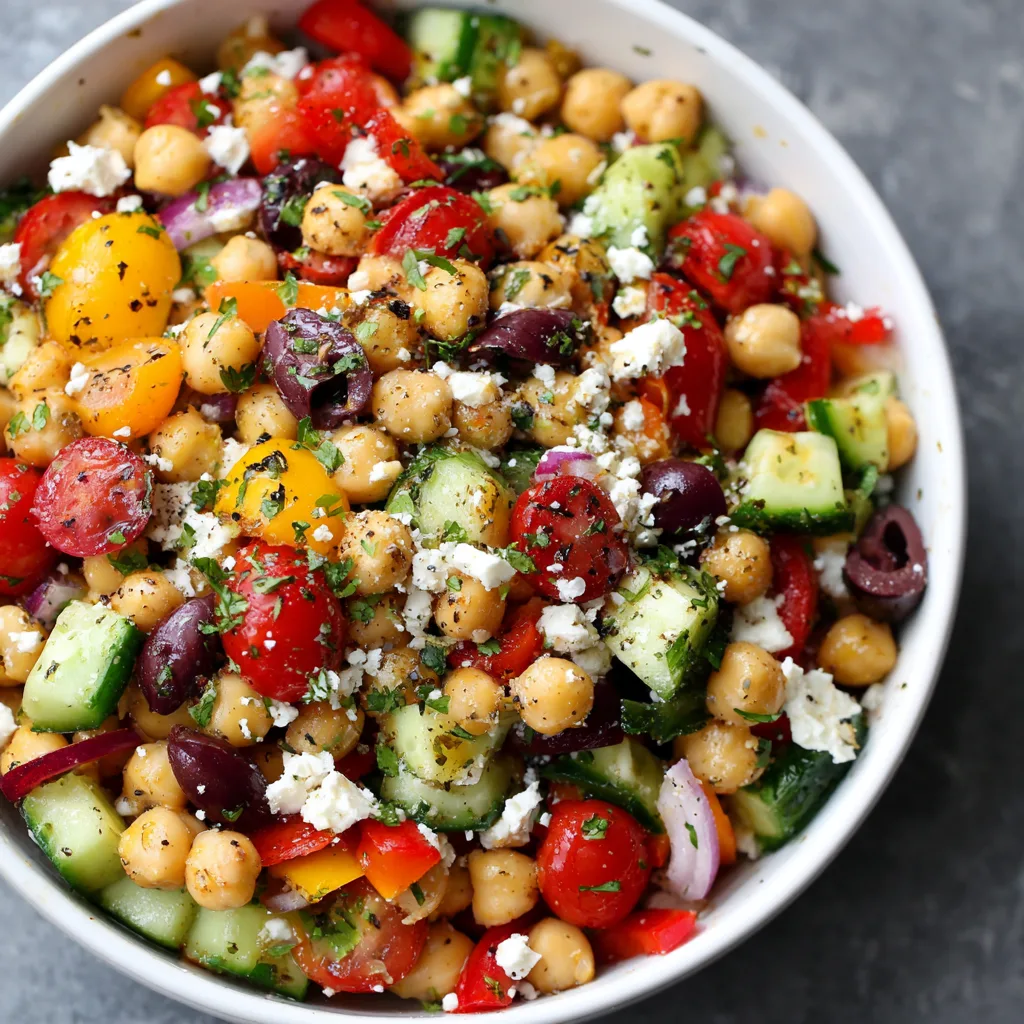Introduction to Mediterranean Chickpea Salad for Kids
Introducing children to wholesome, flavorful meals early sets a strong foundation for lifelong healthy eating. Mediterranean chickpea salad stands out as a vibrant, nutritious dish designed to delight young taste buds while providing essential nutrients. This salad combines colorful, crunchy vegetables with tender chickpeas, creating an appealing texture and visual feast that naturally draws kids in.
What Makes Mediterranean Chickpea Salad Kid-Friendly?
This salad captures kids’ attention with its bright colors and satisfying crunch. Fresh cucumbers, juicy tomatoes, and sweet bell peppers add layers of texture that kids love to explore. Unlike intense or spicy dishes, its mild flavors appeal to delicate palates, making it easy for children to enjoy. Beyond taste and texture, this salad offers a powerhouse of nutrients essential for growth. Chickpeas deliver plant-based protein and fiber, supporting energy and digestion, while fresh vegetables contribute vital vitamins and minerals. Together, these ingredients nurture healthy development without overwhelming young eaters.
Benefits of Introducing Mediterranean Flavors Early
Exposing children to Mediterranean flavors early helps expand their food preferences beyond familiar tastes. The combination of herbs, lemon, and olive oil introduces subtle complexity, fostering curiosity and openness to new foods. Encouraging such variety cultivates positive eating habits, supporting balanced nutrition from a young age. Furthermore, this approach aligns perfectly with pediatric dietary guidelines, emphasizing whole foods and nutrient diversity. By sharing Mediterranean chickpea salad, parents nurture healthy habits that empower children to make better food choices throughout their lives.
Nutritional Profile of Mediterranean Chickpea Salad
Mediterranean chickpea salad offers a powerful mix of nutrients that support children’s growth and well-being. This colorful dish blends protein, fiber, vitamins, minerals, and healthy fats to create a balanced meal that fuels both body and brain. Let’s explore how each nutrient contributes to your child’s health.
Rich Source of Plant-Based Protein
Chickpeas serve as a standout source of plant-based protein, crucial for building and repairing muscles. Unlike animal proteins, chickpeas provide protein along with fiber and essential nutrients, making them a wholesome choice. Compared to meats or dairy, chickpeas offer a gentle option for kids with dietary restrictions or sensitivities. Including chickpeas in the diet supports muscle development and helps sustain energy throughout the day.
High in Dietary Fiber
Fiber plays a vital role in maintaining digestive health, and this salad delivers it abundantly. The combination of chickpeas and fresh vegetables promotes regular bowel movements and prevents discomfort. Fiber also enhances feelings of fullness, helping children avoid unnecessary snacking and supporting healthy weight management. Encouraging fiber-rich foods like this salad can foster lifelong habits that protect against digestive issues.
Packed with Essential Vitamins and Minerals
This salad boasts a rich supply of vitamins and minerals critical to childhood development. Vegetables such as bell peppers, tomatoes, and cucumbers provide vitamins A, C, and K, each supporting immune function, skin health, and blood clotting respectively. Additionally, minerals like calcium and iron found in chickpeas and optional feta cheese contribute to strong bones and healthy blood. Together, these nutrients promote overall vitality in growing children.
Healthy Fats for Brain Development
Healthy fats from olive oil and avocado in this salad play a key role in brain growth and function. These fats support memory, concentration, and mood regulation, all important for learning and social development. Unlike saturated fats, the monounsaturated fats here nurture cognitive function without harmful effects. Including these fats in children’s diets enhances their ability to focus and perform well in school and everyday activities.
Essential Ingredients for a Kid-Friendly Mediterranean Chickpea Salad
Creating a Mediterranean chickpea salad that kids will love begins with choosing fresh, wholesome ingredients. Each component contributes unique flavors, colors, and nutrients, making the salad both tasty and visually inviting.
Chickpeas: Protein Powerhouse and Preparation Tips
Chickpeas stand at the heart of this salad, providing a rich source of plant-based protein and fiber. They support muscle growth and keep digestion smooth. For convenience, canned chickpeas work well but always rinse them thoroughly to remove excess sodium. If using dried chickpeas, soak them overnight and cook until tender. Store cooked chickpeas in an airtight container in the fridge for up to five days to maintain freshness.
Vegetables: Colorful Crunch with Nutritional Benefits
Including cucumbers, tomatoes, bell peppers, and red onions adds vibrant colors and textures. These vegetables supply essential vitamins like A and C, which boost immunity and skin health. The variety stimulates kids’ interest by offering a mix of sweet, crisp, and slightly tangy flavors. Using a rainbow of colors not only enhances appeal but also increases nutrient diversity.
Fresh Herbs: Parsley and Mint for Flavor and Health
Fresh parsley and mint brighten the salad with their lively aroma and taste. Parsley offers antioxidants and vitamin K, supporting bone health, while mint aids digestion and adds a cooling sensation. Incorporating herbs encourages children to explore new flavors gently, enriching the salad without overwhelming their palate.
Optional Add-ins: Feta Cheese, Olives, and Avocado Considerations
Feta cheese introduces a creamy, salty element that many kids enjoy. Olives add depth but can be strong, so consider your child’s preferences. Avocado brings healthy fats and a buttery texture, enhancing brain development. For children with dairy allergies or strict vegan diets, omit feta. Always adjust additions based on dietary needs to ensure the salad suits everyone.
Dressing: Simple Lemon-Olive Oil Vinaigrette Tailored for Kids
The dressing combines fresh lemon juice with quality olive oil, creating a light, zesty finish. To suit children’s tastes, balance acidity carefully, using less lemon if needed. Adding a pinch of mild honey can soften tartness. This dressing keeps the salad fresh and flavorful without overpowering delicate young palates.
Step-by-Step Preparation Guide for Kids’ Mediterranean Chickpea Salad
Making this salad a fun, hands-on experience helps children develop positive food habits. Here’s how to involve them safely and effectively.
Washing and Chopping Ingredients: Safety and Age-Appropriate Tasks
Start by thoroughly washing all vegetables and herbs under cold water. Assign simple tasks like rinsing or tearing herbs to younger kids. Older children can help with chopping softer vegetables under close supervision. Always use child-safe knives or tools suited to their skill level to prevent accidents.
Mixing and Tossing the Salad: Encouraging Participation
Invite kids to combine the ingredients in a large bowl. Show them how to toss gently with salad servers or clean hands, ensuring even dressing distribution. This involvement boosts their excitement and pride in the meal they helped prepare.
Letting the Salad Rest: Enhancing Flavor
Allow the salad to rest in the refrigerator for at least 15 to 30 minutes before serving. This resting time lets the dressing meld with the vegetables and chickpeas, deepening the flavors. However, avoid prolonged storage after dressing to keep vegetables crisp and fresh.
By carefully selecting ingredients and involving kids in preparation, you turn a simple Mediterranean chickpea salad into a nutritious, enjoyable family favorite.
Creative Ways to Serve Mediterranean Chickpea Salad
Mediterranean chickpea salad offers versatility beyond the bowl. Serving it in creative formats can excite kids and make mealtime more enjoyable. Let’s explore some kid-friendly serving ideas that combine nutrition with fun.
Salad Wraps: Whole Wheat Tortillas Kids Love
Wrapping the salad in whole wheat tortillas transforms it into a portable, easy-to-eat meal. The soft, warm wrap contrasts with the crunchy vegetables, making each bite interesting. To appeal to children, cut wraps into smaller pinwheels or fun shapes. You can also add a thin layer of cream cheese or mild hummus before adding the salad to enhance flavor and moisture.
Salad-Stuffed Pitas: Combining with Hummus or Yogurt
Stuffing the chickpea salad into pita pockets turns it into an interactive meal. Spreading hummus or a mild yogurt inside the pita adds creaminess that balances the fresh crunch. Kids enjoy holding and assembling their own pitas, which encourages engagement and makes eating exciting. This format works well for lunchboxes or quick dinners.
Salad Bowls: Layering with Grains and Protein
Building a salad bowl by layering chickpea salad over grains like quinoa or couscous boosts the meal’s heartiness. Adding grilled chicken, tofu, or boiled eggs introduces extra protein, making it more filling. Customize the bowl by arranging ingredients in colorful sections. This visual appeal invites kids to try every component.
Variations to Suit Different Tastes
Not all kids have the same preferences, so adjusting the salad to suit individual tastes helps increase acceptance and enjoyment.
Sweet Additions: Balancing Flavors with Fruits
Adding sweet elements such as raisins or diced apples brings a pleasant contrast to the savory salad. The natural sweetness can help picky eaters accept vegetables more easily. Make sure to balance the sweetness with tangy or salty flavors to keep the salad well-rounded.
Texture Modifications: Crunch and Smokiness
Roasting chickpeas until crispy adds a satisfying crunch that appeals to many children. Similarly, grilling vegetables like bell peppers or zucchini imparts a smoky flavor that enriches the salad. These texture shifts keep the dish interesting and can help kids explore new sensations.
Flavor Adjustments: Herbs, Spices, and Dressings
Experiment with different fresh herbs like basil or cilantro to introduce new flavors. Mild spices such as cumin or paprika can add warmth without overwhelming young palates. Adjusting dressing ingredients by reducing lemon juice or olive oil can tailor the taste to children’s preferences, ensuring the salad stays approachable and delicious.
These serving ideas and variations turn Mediterranean chickpea salad into a versatile, customizable dish that suits diverse tastes while keeping nutrition front and center.
Common Questions About Mediterranean Chickpea Salad for Kids
Parents often wonder how to best prepare and serve Mediterranean chickpea salad to suit their family’s needs. Here are answers to some frequently asked questions that help make this dish convenient, tasty, and kid-approved.
Can I Make This Salad Ahead of Time?
Yes, preparing the salad in advance can save time on busy days. When meal prepping, keep the dressing separate until just before serving to prevent soggy vegetables. Store the salad base—chickpeas, vegetables, and herbs—in an airtight container in the refrigerator for up to two days. Add dressing and toss the salad shortly before eating to maintain crispness and freshness.
How Can I Make the Salad More Appealing to Picky Eaters?
To win over picky eaters, start by introducing the salad’s components one at a time. Let kids explore each vegetable separately to build familiarity. Use colorful veggies to make the salad visually enticing. Cutting ingredients into fun shapes or bite-sized pieces encourages children to try them. Offering dips like mild yogurt or hummus on the side can also make new flavors more approachable.
Is This Salad Suitable for School Lunches?
This salad works well for school lunches if packed thoughtfully. Use a sturdy, leak-proof container to keep ingredients fresh and prevent spills. To avoid sogginess, pack dressing in a small separate container for mixing at lunchtime. Include a small ice pack to maintain a safe temperature and preserve crisp textures. Adding a side of whole grain crackers or pita chips can make the meal more satisfying.
Can I Freeze Leftover Salad?
Freezing Mediterranean chickpea salad is not recommended. The fresh vegetables tend to become mushy after thawing, affecting texture and taste. If you have leftovers, store them in the refrigerator and consume within two days. For longer storage, freeze cooked chickpeas separately before mixing them fresh with vegetables and dressing at serving time.
By following these tips, you can enjoy Mediterranean chickpea salad easily and confidently, ensuring it remains a healthy and delicious option for your kids.
For Kids Mediterranean Chickpeas Salad – Fresh, Fun & Nutritious Meal Idea

This vibrant and nutritious salad blends tender chickpeas with fresh vegetables and a zesty lemon-olive oil dressing. It offers a perfect balance of flavors and textures, making it ideal for kids’ lunches or healthy snacks.
Ingredients
- 1 can (15 oz) chickpeas, drained and rinsed
- 1 cucumber, diced
- 1 cup cherry tomatoes, halved
- 1 bell pepper, diced
- 1/2 red onion, finely chopped
- 1/4 cup fresh parsley, chopped
- 1/4 cup feta cheese, crumbled (optional)
- 1/4 cup kalamata olives, pitted and sliced (optional)
- 1 avocado, diced (optional)
- 2 tablespoons olive oil
- 1 tablespoon lemon juice
- Salt and pepper to taste
Instructions
Notes
- For a vegan option, simply omit the feta cheese.
- To make the salad more substantial, mix in cooked quinoa or couscous.
- Store leftovers in an airtight container in the refrigerator; consume within 2 days for optimal freshness.
This easy, no-cook recipe encourages kids to enjoy healthy eating with minimal preparation and maximum flavor.




